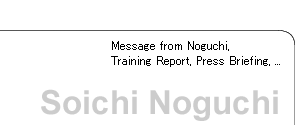Astronaut Noguchi's Training Report, #11
Tough Summer
Last Updated: November 11, 2004
Hello, my friends in Japan, this is Soichi Noguchi in Houston!
It is mid-summer now in Japan and I imagine you are enjoying the summer holidays. I imagine that you must be enjoying outdoor amusements, like going to beaches and the mountains, while others must be studying very hard for the coming entrance exams. We of the STS-114 crew are also having a tough summer preparing for the return to flight (RTF) scheduled for next year. It’s been one and a half years since the Space Shuttle Columbia accident. The countermeasures in response to the recommendations of the Columbia Accident Investigation Board (CAIB) are gradually showing their effects, which will accelerate the movement to return to flight.
This training report tells you about our daily activities in the style of a summer vacation picture diary.
2004-07-19 (Monday)
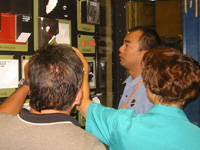 |
Week one started with the regular meeting at eight in the morning. All of the astronauts in Houston gathered around astronaut Rominger in the Chief Astronaut’s Office at Johnson Space Center, to check the schedule for the week and the progress of the various projects. All of the members of the STS-114 crew attended the meeting. Many themes concerning the RTF were addressed and we listened intently. We feel that many astronauts support the STS-114 mission in a variety of ways. After the meeting, we received a briefing from the trainers about the simulations for the week.The week’s schedule was tough, as usual. The measure concerning tile-repair-technique development was an important topic for RTF. Since I was assigned as the main Extra Vehicular Activity (EVA) astronaut, I was nervous, even concerning the small points of the development tests. Would hardware development be ready in time for the launch scheduled for next spring? This will be a tough summer for both crew and engineers.
2004-07-20 (Tuesday)
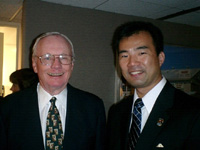 |
All of the STS-114 crew members visited Washington. We were invited to the 35th anniversary ceremony of Apollo 11’s moon landing, held at the Smithsonian Museum. At the site, we found many astronauts of the Apollo era arriving one after another: Eugene A. Cernanof Apollo 17, James A. Lovell of Apollo 13, and today’s main guests, Neil A. Armstrong, Buzz Aldrin,and Michael Collins of Apollo 11. During the ceremony, NASA Administrator Sean O’Keefe honored the brilliant achievements of the Apollo Plan. He introduced us, the STS-114 crew, as members of the project leading to the future of NASA. Commander Armstrong and the other astronauts stood up and applauded us, and I felt quite embarrassed yet proud. I personally had no memory of the first Moon landing, so I felt especially honored that we were invited, as their successors, to the ceremony that was held 35 years after their great achievement. After the ceremony I asked Mr. Armstrong to have a picture taken with me. It turned out like this, and I hope I wasn't impolite. Isn’t this a good smile?
2004-07-21 (Wednesday)
When I came to the office and checked my voicemail, I was surprised to find quite a rare one. Oh boy! It was mail from astronaut Michael Fincke who was staying in the International Space Station (ISS). Using the software “IP Phone,” astronauts can call public telephones. Last week I e-mailed him about EVA, so this was his response. Astronaut Fincke and I are graduates of the same astronaut class and have been friends for eight years. When he was selected as an astronaut, he was staying in Gifu Prefecture Japan on business, and I first met him at the office of the former NASDA headquarters in Tokyo. He spoke Japanese well, and he has many friends in Japan. He has now been aboard the ISS for more than 100 days, and everything has been fine. He has two more scheduled EVAs. I hope he remains well for the rest of his time aboard the ISS.
2004-07-23 (Friday)
I performed a tile-repair evaluation test using KC-135 aircraft. By flying a parabolic trajectory, the KC-135 can generate approximately 20 seconds of zero gravity. We conducted various scientific experiments or equipment evaluation tests used in space during that period. Usually parabolic flights were repeated about 40 times, but today we tried as many as 65 flights. Astronaut Wakata joined this flight and evaluated the tile-repair technique that we will conduct in our STS-114 mission. I slipped in this easygoing scene (smile!) while we were busy conducting the tests. I hope it will be allowed, as it can be a good public relations activity for JAXA. Since the summer of last year I have experienced more than 500 parabolic flights, even though they were only for tile repair. However, no matter how many times you experience zero gravity, it is always interesting. How I long to go into real space soon.
2004-07-26 (Monday)
Beginning with the meeting at eight in the morning, a day full of tight training schedules lasted until seven in the evening. The six hours of continuous simulation training was especially tough. In the training facility, which simulates the Space Shuttle’s mid-deck, we responded to various errors set up by the trainers without taking a break. Afterwards, during debriefing, we rigorously reviewed the training. Any mistakes we made were pointed out to us and we were never able to relax. Happily, no big mistakes were found in the latest training. Today, a selected group of Boy Scout members from Chiba prefecture, Japan visited NASA. Unfortunately, I could not see them since I was in training, but I asked the public relations personnel to give them some personally autographed photos. I heard that they were happy to receive them, which made me happy as well.
2004-07-28 (Wednesday)
I flew a T-38 jet trainer to Pensacola Naval Base in Florida. Three Japanese ISS astronauts (Furukawa, Hoshide, and Yamazaki) were training there. The purpose of my visit was to encourage them while they attended instrument flight training as part of the astronaut candidate (ASCAN) training. At Pensacola, Yamazaki, who is darkly tanned (oops! golden brown) welcomed me. Later, astronauts Hoshide and Furukawa returned from their flight training. All three astronauts were really fine. Healthy tanning in the continual Florida summer might be why they looked so good. They will start full-scale training in August. I recall that eight years ago I came to Houston with astronaut Mohri to receive ASCAN training. I attended survival training with him here at Pensacola. At that time we didn't have enough food, so after the training we rushed to a fast food store. I fondly remembered those times as I boarded the T-38 and left Pensacola.
2004-07-29 (Thursday)
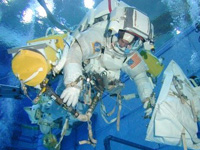 |
We had EVA training using the Neutral Buoyancy Laboratory (NBL). We arrived at the NBL at seven, and activities started early in the morning. Cranes began to move after six, cars carried air tanks, divers began to swim to warm up, and around seven we, the trainee crew, started checking training procedures and prepared tools for the day. Although it might be a strange analogy, I felt like I was in a fish market. The whole area was full of activity, which was very exciting. For EVA training, the buoyancy facility was most effective. It is the closest environment to being in space. Today’s theme was Space Shuttle tile-repair training. It was thorough training, starting from the airlock hatch opening to the end of EVA. Many new tasks were included that interrupted training. We tended to make simple errors under such conditions. In cooperation with my EVA partner, astronaut Robinson, we further confirmed each procedure. Eventually the underwater training took six hours, and somehow we completed the scheduled tasks. However, it was not the end of the day for us. Referring to the precise notes that the instructors recorded during six hours of training, we had two hours of debriefing to review some points and discuss others that needed to be improved and modified for the next training procedure so that we wouldn't forget. At the end we were exhausted, but this training cycle was very important. Closer to the launch, we repeated underwater training almost everyday to gradually improve our skills. EVA might look glitzy and glamorous, but it is a hands-on procedure of many small actions based on activities at the site. This sense of “hands-on” might be why I love the sense of imparting some Japanese craftsmanship as the main EVA astronaut.
2004-07-30 (Friday)
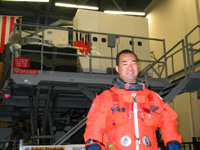 |
Ascent simulation began in the morning using the Motion Base. This was training to respond to any Space Shuttle launch emergency, and commander Collins and astronauts James M. Kelly, Stephen K. Robinson, and I attended. In this simulation, the situation changed every second and attendees were expected to conduct the necessary operations without making any mistakes. In the case of failure, each person has to act appropriately, following the manual. In addition, the crew immediately has to consider the whole situation, support the commander in setting up a crew-coordination plan, and act based on that plan. The training was designed to evaluate the risk-management ability of a four-member crew. Naturally, every judgment and operation must be backed up by a deep understanding of Space Shuttle systems and the operational experiments on them, which eventually leads to a total understanding of the Space Shuttle. We conducted five launch simulations in four hours. The STS-114 crew has been training for three years, even before the Columbia accident, yet every time we attend the training we find new items and realize new points to improve. This is proof that our team is still growing, and I am sure that we will continue this effort to develop our team’s maturity until the morning of launch day.
*Motion Base
A Shuttle Mission Simulator (SMS) used in training for launch and landing operations or in-orbit operations training is located at Johnson Space Center. The SMS is composed of Motion Base (MB) and Fixed Base (FB) equipment. SMS-MB is used for launch and landing training. The cockpit is set vertically and simulates launch vibration for launch training. The landing attitude and other conditions are simulated for landing training. SMS-FB is primarily used for orbital operations training, however it can also be used for thorough training from launch to landing.
How did you feel in reading this diary? I hope you were able to get a sense of our daily life in training. In writing this report, I found myself surprised at all the various things we do every day, which might be an indication that I am not watching myself carefully. My thoughts are focused upon doing my best for the Space Shuttle RTF and for us, the STS-114 crew. The Space Shuttle RTF will be the realization of our dreams and for us nothing is more important. However, it will be a long, hard road that we will have to endure. This summer gave us crew members the opportunity to develop our determination to overcome all difficulties as a team, and to proceed along the long road toward the same destination. I believe that this summer will long be remembered by the crew members as their most meaningful, and one that is full of good memories.


